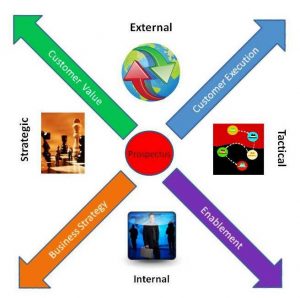Somewhat surprisingly, we all probably know what we mean when we use strategy as an adjective, “strategic”, but manage to make a complete muddle out of the word as a noun, “strategy”. Can our tactics be strategic? I would think yes, if they are in accordance with some strategy. Can more than one thing be strategic at a time, can we have multiple strategies? Yes, and Yes again. So what sits on top of those, if anything - a strategic strategy? A master strategy?
To make sense out of this it helps to have a larger framework, an overall architecture, with which to impose order on our thinking and our business structure. While the Kaplan-Norton Balanced Scorecard is certainly the most familiar of these frameworks, perhaps it just doesn’t seem to work for you, doesn’t fit your business or your culture. What’s a strategist to do? Develop your own, of course. It’s more important that it work for you than that it have four distinct, pre-labeled, certified layers.
 A quick example*. Two dimensions: Strategic versus Tactical going left-to-right, and External versus Internal going from top-to-bottom. Here’s what that looks like:
A quick example*. Two dimensions: Strategic versus Tactical going left-to-right, and External versus Internal going from top-to-bottom. Here’s what that looks like:
Now, what does this mean? Along the Green arrow are the components of your Customer Value Strategy, and staying on the strategic left side of the diagram, the Orange arrow represents the elements of your Business Strategy. On the tactical right-hand side, the Blue arrow represents how you will Execute for Customer Value, and the Purple arrow represents your Enablement Execution.
What might these broad categories be comprised of? Here is a suggested list to get you started:
As for the Red circle in the middle labeled “Prospectus”, this is the master strategy that links everything together. Perhaps, in “Good to Great” fashion, this is your ‘hedgehog’, your single organizing idea. Whatever and however you choose, it must contain one critical concept: it must be limiting in some form or fashion. While your master strategy needs to be flexible, adaptable and open to new opportunities, it cannot include everything under the sun. If it to be of value, not only must it guide you in what to do, what to invest in, it must also offer similar guidance regarding what NOT to do, acting like the prospectus of an investment fund, defining the business both in positive terms and at a minimum implying exclusion outside of the stated objectives.
Selecting the key components of the framework is only the first step, but it’s a big first step to clear up the muddle.
2) Flesh out the definitions of each component
3) Assign an owner to each component
4) Determine appropriate KPI’s for each
5) Define the linkages and dependencies between each (huge task)
6) Communicate the strategy, the KPI’s and the integration
7) Once you have some history, test the KPI’s and the components themselves for relevancy to the results.
'8) Test, revise, adapt, adjust, modify. Take this last step as a given – things change, and so will your strategy.
* with acknowledgement to Austen Mulinder, former CEO of Fujitsu Transactions Solutions.

